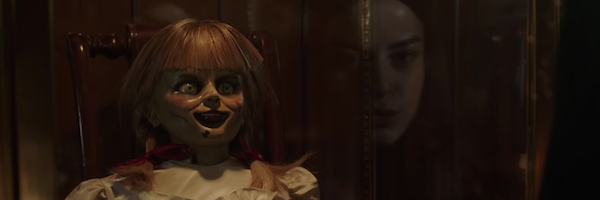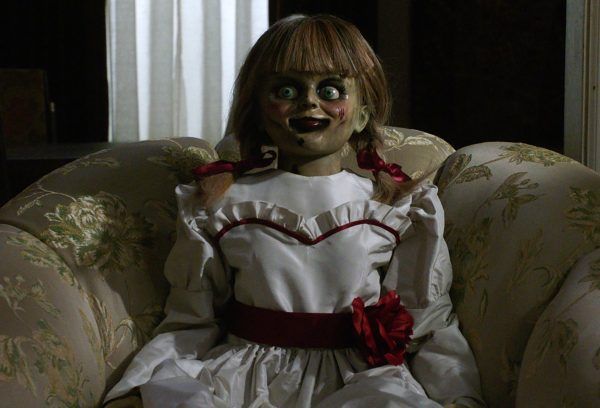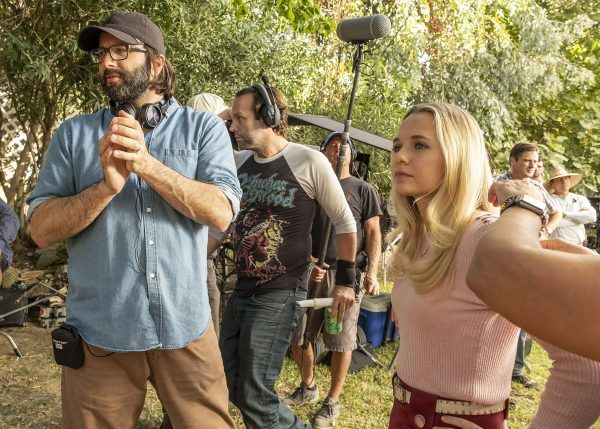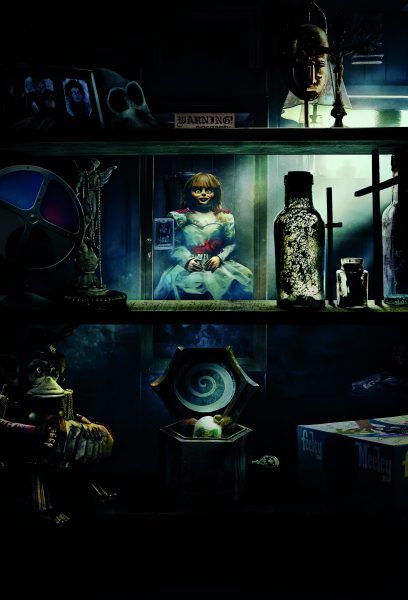Annabelle Comes Home is the third installment of the hugely successful Annabelle films, starring the infamous sinister doll from The Conjuring universe, and this one tells the story of what happened when demonologists Ed (Patrick Wilson) and Lorraine Warren (Vera Farmiga) brought it home to place it behind sacred and blessed glass in the locked artifacts room in their home. When the evil spirits in the room are awakened by the possessed doll, they all set their sights on the Warrens’ young daughter Judy (Mckenna Grace), her babysitter Mary Ellen (Madison Iseman) and Mary Ellen’s best friend Daniela (Katie Sarife).
On November 14, 2018, Collider (along with a handful of other online outlets) was invited to the set on the Warner Bros. Studios lot in Burbank, Calif., where we got to talk to franchise producer Peter Safran, who has produced all of the films through The Safran Company. During the interview, which was held on a soundstage in a room that was filled with a variety of crosses (one of which would periodically spin on the wall), photos and posters from previous films in the universe, he talked about how they came to focus this film on Judy Warren, why they chose this particular time period, whether this is a stand-alone film, why it was time for Gary Dauberman (who wrote the previous two Annabelle films) to sit in the director’s chair for this third installment, when they realized they had an entire horror cinematic universe, how much more they think that universe can expand, and whether producer James Wan might ever direct another one.
Question: Usually The Conjuring films and the Annabelle films might have Ed and Lorraine Warren, but they are about a different family. Where did the decision come from, to focus on Ed and Lorraine, specifically?
PETER SAFRAN: Well, it’s less Ed and Lorraine, and more Judy, but the idea for bringing it back to the Warren family was something that we’ve been toying with for awhile. We had the parents, we had the Hodgsons, and we’ve taken it all away to Romania, with a totally different vibe and feel for The Nun. We just liked the idea of bringing it closer to home, back to ordinary people in extraordinary circumstances, which was the touchstone for it. That just really made sense. We always loved the idea of the artifacts room being the potential source of more stories. The idea for actually setting a film around that was something that we had in our mind for awhile, and Gary [Dauberman], James [Wan] and myself just thought that the 3rd Annabelle movie was an opportunity to really raise the stakes. Also, the opening scene of The Conjuring is so iconic, when it opens up on the half-face of Annabelle, and we just always liked the idea of, what happened after they left there? We see them taking the doll, but what happens? It was actually something that other people had asked us, in the past, as well. We just thought we would explore that story.
Regarding the timeline and from looking at the artifacts room, does this film take place after the first The Conjuring but before The Conjuring 2?
SAFRAN: That is correct. That’s exactly right.
How did you settle on that?
SAFRAN: We wanted it to be close in time to the prologue of The Conjuring, where they take the doll. So, we knew that it was gonna be somewhere in that range, whether it was immediately upon bringing the doll home, or six months later, or a year later, and I think we settled on a year later, we wanted Judy to still be young Judy, in the early ‘70s, as opposed to ‘77 for the Hodgsons. We knew it would lie somewhere in there, and we wanted it to be pretty close to the time in which they brought the doll home.
How dependent on all of the previous films is this one? Can you watch this fresh and take everything in, but also pick up on little connections, if you have seen the others?
SAFRAN: That’s exactly it. There are actually a lot of connections to the other films. They are there to be picked up by the viewer who’s seen the other movies in The Conjuring universe, but it is very much a standalone film because we really do tell a chronological story. We have Ed and Lorraine bringing the doll home, and then the story leads from that. It’s very much a standalone film, but for everybody who’s seen the other movies, you’ll get to know Judy. You’ve been in the artifacts room, a couple of times in the other movies, so to see that built out, there’s a lot for people to draw from, if they’re fans of the universe.
Gary Dauberman has been involved with this universe for so long now, as a writer. Was it just a natural evolution for him to step into the director’s chair, at this point?
SAFRAN: It was the easiest decision that we’ve made, with the whole franchise. He wrote Annabelle 1, Annabelle 2 and The Nun, and he spent a lot of time on set on all three of those movies, but particularly The Nun, where he was on set, every day. He got to a place, as a writer, where he wanted people to stop fucking up his movies. He really didn’t want to write another one and hand it off. We know him so well, and he’s learned so much, at the hands of James [Wan], from working with him so closely, that it was like going to a university on how to craft scares. He was really ready to make that move, and we all identified Annabelle 3 as the one where he should do it. It was just really a natural progression. We tried to keep The Conjuring universe family together, so there a lot of people that’ve worked on all six movies, or four or five movies, and we try to elevate them up. When you find someone you really like working with, you wanna give them the opportunity to grow, and James loved working with Gary, since the first Annabelle, so it was inevitable. If he was gonna direct, we wanted it to be for us.
Each of these films have a similar rhythm about them. Is that the case here, or is this more of a standalone, in terms of the vibe?
SAFRAN: We always try to make sure that we’re not diluting what we’re doing, and that we’re telling stories that just stand on their own. The Conjuring 1 and The Conjuring 2, which were both James Wan, have similar rhythms. With Annabelle: Creation, we intentionally took it away from just a family home. With The Nun, we took it to Romania, giving it a completely different vibe. We try to find ways to make sure they don’t feel repetitive, and I think we’ve been pretty successful in doing that. With this one, though we’ve brought it back home and it’s in the Warren house, like it was in the first The Conjuring, the movie has a very different feel. It all takes place in one night, as opposed to being stretched out over the course of a family story. So, we feel like it definitely stands alone, as its own tone and vibe.
When did it actually sink in that you guys had created and entire The Conjuring cinematic universe?
SAFRAN: After the first one was successful, a buddy of mine said, “You don’t have a franchise until your second one really works. Until then, all you have is one good movie.” There have been plenty of good movies in the genre, particularly horror. They first one is great, but then they never manage to replicate it. So, I think obviously the success of Annabelle, commercially, even though it was not what we hoped it was gonna be critically, it was evident that people have a real appetite beyond Ed and Lorraine Warren, and they liked the idea of this world that we were living in. I don’t think we used the term “universe” until we were well beyond Annabelle: Creation. It just became clear that people had a real interest in what we were doing. From the very get go, we knew that the Warrens had a lot of case files and we liked the idea of being able to draw from them. That led us to where we are today. When we handed James Wan the original script for The Conjuring, it didn’t have Annabelle. It didn’t have that opening in there. James said, “Let’s put that in, as the opening of our movie,” and I think he did that knowing that there would be some real interest in Annabelle, and he was right, as always.
You have The Conjuring 3 in line to go into production and you’re developing The Crooked Man. Moving forward, how does each movie change and affect what you’re developing?
SAFRAN: After doing the first The Conjuring movie and it being as successful as it was, the studio was clamoring for a sequel. We always felt that we were not going to make another movie unless we thought there was a story we could tell that was worthy of being a The Conjuring movie. That’s been a mandate for each of these. To greater or lesser levels of success, that’s always been the mandate going in. It’s about, do we have a story we wanna tell that really merits being part of The Conjuring universe, and is not just a scary movie? We feel like this one satisfies that goal because it’s different enough.
How much more do you think that the universe, or franchise, can expand, as far as titles? Do you think there’s more beyond The Conjuring and Annabelle?
SAFRAN: Sure, yeah, as long as you keep having original stories to tell. The moment that you start repeating yourself and really diluting the good will that exists out there, then it’s the beginning of the end, and you become Police Academy 9. We’re all happy to walk away from it, the moment we don’t feel like we have a movie that lives up to it. We really are. We would stop tomorrow, if we didn’t have another one. The script for The Conjuring 3 is absolutely fantastic, and it is a real departure from The Conjuring 1 and The Conjuring 2. We’re ambitious, in our attempts to make sure that we’re telling an original story. There are other stories to be told. Each one of them will have its own original feel, and some will involve Ed and Lorraine and the Warrens, and some won’t. The Nun shows that we can make different kinds of movies that don’t involve our principal characters in significant roles, but can really support a great film.
You mentioned the case files and artifacts room. Is there one story, in particular, that you’d like to see become a film?
SAFRAN: No, not yet. There are a bunch of things that we’re exploring, in this film, that I just love, and I think are gonna be great. Frequently, the audience tells you what the next one should be. When we did The Conjuring 2, we all thought The Crooked Man would be the next one out of the gate. We just loved it. It’s a great character. Instead, the audience was so fascinated by the Nun, and so many people were directly messaging James about, what was her origin? Who is she? Where did she come from? There was just a real fascination, so it was clear that, in fact, should be the next one. It’s not that we won’t do The Crooked Man. You just have to balance out the demand. So, we have ideas of what we want to do beyond this, from the artifacts room, but I suspect the audience will tell us exactly what we should be doing.
Do you think James Wan will come back and direct again in this universe?
SAFRAN: I don’t think he will, but that’s just me. My instinct is that he won’t. I think he really left everything out on the field with The Conjuring 2. Being by his side as he made that movie, I feel that he put everything that he’d learned, up to that point, into that film, from character development to scares to crafting sequences, and everything. I love that movie, and I think that he felt like he really showed people exactly what he wanted to show them, with the skills of a filmmaker telling a great story. So, I would be surprised, if he ended up doing another one, but you never know. With a guy like James, scares are in his blood. They need an outlet for it, at some point, but maybe he’s getting it out, as a producer. There’s something very compelling about sitting there, wanting to scare the shit out of people.
Annabelle Comes Home is out in theaters on June 28th.




